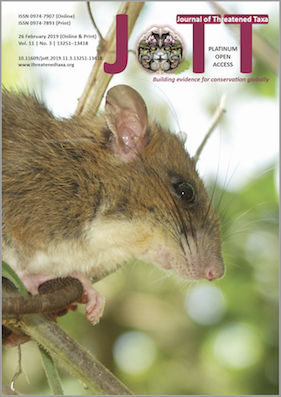Rediscovery of the ‘extinct’ bee Hesperocolletes douglasi Michener, 1965 (Colletidae: Colletinae: Paracolletini) in Western Australia and first description of the female
DOI:
https://doi.org/10.11609/jott.4610.11.3.13310-13319Keywords:
Banksia woodlands, Douglas’s Broad-headed Bee, global biodiversity hotspot, Hesperocolletes, pollinator, rediscovery, Southwest Australian Floristic Region, threatened speciesAbstract
The second known specimen of the bee Hesperocolletes douglasi Michener, 1965 is here reported as a serendipitous find among a collection of insect pollinators from an isolated woodland remnant in the Southwest Floristic Region of Western Australia. The unique male holotype of this monotypic genus of bees was collected 80 years ago and officially gazetted as presumed extinct in 1994. With our collection of a female specimen in 2015, however, it now appears that H. douglasi may persist as an extant localised population. Follow-up efforts to find more specimens at the collection locality so far proved unsuccessful, indicating that the species is likely either very rare or inhabits an ecological niche that is yet to be discovered. Analysis of the pollen load carried by the female indicates that the species may be polylectic. We discuss the context of the rediscovery of the bee, provide a detailed description and illustrations of the female, and make observations about the unusual morphological characteristics of the species. The rediscovery of H. douglasi emphasizes the importance of conservation efforts for remnant woodlands in the region, both as potential habitat for the bee and as remaining habitat essential for other rare and threatened species in this global biodiversity hotspot.
Published
Issue
Section
License
Authors own the copyright to the articles published in JoTT. This is indicated explicitly in each publication. The authors grant permission to the publisher Wildlife Information Liaison Development (WILD) Society to publish the article in the Journal of Threatened Taxa. The authors recognize WILD as the original publisher, and to sell hard copies of the Journal and article to any buyer. JoTT is registered under the Creative Commons Attribution 4.0 International License (CC BY), which allows authors to retain copyright ownership. Under this license the authors allow anyone to download, cite, use the data, modify, reprint, copy and distribute provided the authors and source of publication are credited through appropriate citations (e.g., Son et al. (2016). Bats (Mammalia: Chiroptera) of the southeastern Truong Son Mountains, Quang Ngai Province, Vietnam. Journal of Threatened Taxa 8(7): 8953–8969. https://doi.org/10.11609/jott.2785.8.7.8953-8969). Users of the data do not require specific permission from the authors or the publisher.





